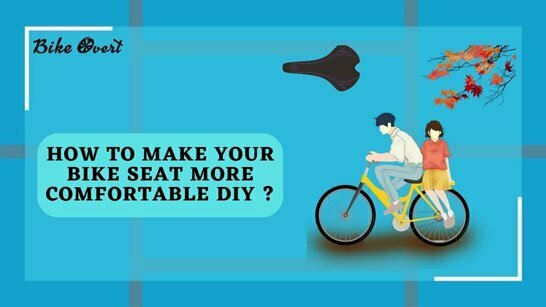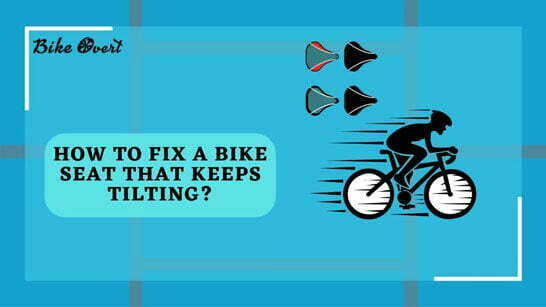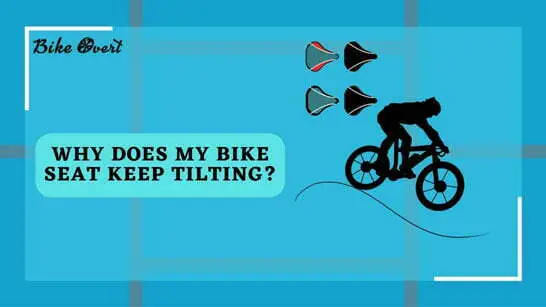Why does my bike seat keep going down? Some possible reasons a bike seat keeps going down. Should bike seat be higher than handlebars?
There is a variety of reasons why your bike seat keeps going down. The first thing you should do is to make sure that your seat post isn’t too long or too short. If the seat post is not the problem, then it could be a problem with the saddle clamp bolt. There can also be a problem with the seat, if it’s bent or missing parts.
The average bike seat is designed to be at the proper height when the rider is sitting straight up. There are several reasons why this position may not be reached. Age, weight, and height all affect how much seat the rider sits on. What may also be affecting your seat is that you’re riding an improperly sized bike. If your bike has gears or brakes, try them out. If they seem fine, you might need to adjust the seat height to accommodate for these features.
Fundamentals of a bike seat
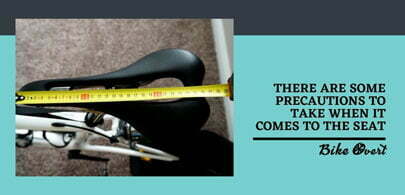
While your bicycle may be your ride of choice for getting around town, there are some precautions to take when it comes to the seat. The first is to make sure you purchase a seat that is specifically designed for your type of bike. There are different types of seat available-depending on the type of riding you will be doing-ranging from leisurely rides around your neighborhood to long-distance biking through rough terrain.
The first thing you need to be aware of when picking out a bike seat is that there are no standards for what size bike seats are. The second important factor is your height. Generally, if you are short, you will want to get an extra small frame with an extra small seat or a medium frame with a small seat. If you are taller, you might go for a bigger frame for more balance and stability.
Some possible reasons a bike seat keeps going down
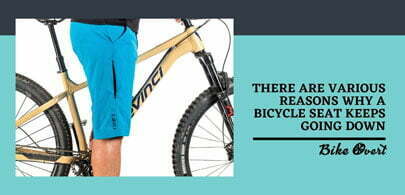
There are various reasons why a bicycle seat keeps going down. I am going to tell you some important reasons that will help you understand what’s happening with your seat so that you can fix it yourself. The first thing we should do is check if there is anything wrong with the saddle itself. It could have been damaged by water or dirt.
- The saddle isn’t properly adjusted. This means that there aren’t enough holes in the saddle to allow airflow through the material. When sitting on the bike, heat builds up between your legs and buttocks because there is no airflow. It will cause discomfort and eventually lead to soreness.
- Your weight distribution is off balance. If you have an uneven amount of pressure being applied by your body parts then this may result in the seat moving downward. You should try adjusting the position of your feet or even changing positions while riding.
- There are too many people using the same bike. Too much traffic can make a bike uncomfortable for one person but not another. Try taking out some riders so that only two or three bikes are sharing space at any given moment.
- The handlebars are set up incorrectly. This could be due to improper adjustment, poor maintenance, or just plain bad design. Make sure they’re adjusted properly before getting on the road.
- Your tires aren’t inflated correctly. If you have flat spots and/or uneven wear it might mean that your tire pressure is off. Check with your local shop about how to adjust them.
- It might be assembled incorrectly. Look closely at the seat post clamping mechanism. Is there enough clearance? Are all of the bolts tight? Does the frame look like it was built by someone who knows what he’s doing?
- It might be dry (not lubed). A bike seat can get very hot in a hurry if not lubricated well. You should always check for any signs of moisture when buying new bikes.
- It might just have loosened the bike seat. This happens sometimes, especially on older models where the bolt heads are worn out or corroded. Just fix it to stop your bike from going down.
What equipment is required to stop a bike’s seat from keeping it going down?
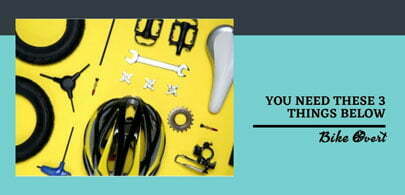
Do you want to stop your bike’s seat from going down? You need these 3 things: an allen wrench, a seat post bolt, and a spring. But there are various sizes of allen wrench so make sure that you get the allen wrench that fits properly before attempting to tighten the seatpost bolt. If you don’t have access to a proper tool then try using a flathead screwdriver instead.
How do I stop my bike seat from slipping down?
It can be a very frustrating experience when going for a bike ride and the bike seat starts to slip down, leaving a sore backside after a few miles.
Most commonly, this problem is caused by dirt or grime that has accumulated under the bike seat and doesn’t allow it to properly grip the bike. In order to stop this from happening, it’s best to keep the bike clean from any dirt accumulation as much as possible.
This can be done by tightening the bolts on each side of the front of the seat, changing the angle with which the seat is angled towards the ground, or switching to a different type of saddle. Another option is to switch to a padded, gel or water-resistant saddle if you are prone to sweating while riding.
You can do these things:
Clean and put any tidy grease on the seatpost.
The cycling seat post is a crucial component of the bike frame. It connects the seat to the frame and allows for adjustments as one pedals. The seatpost should be greased up every few months to maintain its performance.
In order to keep your bike running smoothly, it is important to clean and apply new grease to the seatpost. There are many different types of grease, but the most common ones are lithium, white lithium, and petroleum jelly.
Different greases have different properties and can be better for certain applications. When greasing a seatpost it is important that you use a light layer of grease on the post.
Double Check the Seat Post Size
One of the most common mistakes when trying to install a bike seat is an incorrect measurement for the seat post size.
The seat post size is the distance from the center of the bottom bracket to the top of the seat post. The size should be measured horizontally and it’s important that this measurement be accurate because you don’t want the bike saddle to be too high or too low.
Bike seats are made in one-inch increments, which means that there are many different size options. More importantly, these sizes can change depending on the type of bike you have. When in doubt, double-check the seat post size before buying with a tape measure or ruler.
Check and replace the seatpost clamp
The seatpost clamp is an often-overlooked component on a bike. It’s important to check the seatpost clamp because a loose seatpost clamp. Because a wonky saddle height that can lead to back pain and other issues. To fix this problem, take the seatpost out, tighten the screws, and then put everything back together. This should be done every two years as preventative maintenance.
One thing is important, there are various sizes of seat clamps that can fit different sized seats. If your seat has no markings indicating its size, it may not work well for you. You need to make sure that the seatpost fits properly into the seat tube so that it doesn’t slip around when pedaling. So choose the right one.
Adjust the seat post positioning
Posture for cycling is an important part of the experience. The seat post needs to be adjusted for various types of cycling. Whether it be an uphill climb, a long-distance pedal, or spinning out on the flats, the positioning of your seat post will make a difference in how comfortable you are.
When adjusting your seat post positioning, there are several things to keep in mind. If you have a lot of knee bend when the pedal is at the bottom of the stroke, then that’s because the saddle needs to be raised higher. If you have a lot of heel strikes or your saddle is too high, then it might be time to lower the saddle.
Apply Carbon Paste
Carbon paste is an adhesive that helps keep the cover off of the seat in place. Without the right adhesive, it can be very easy for the fabric to slip and slide around when in use. It’s important to keep in mind that carbon paste should not be used on materials that are not able to withstand adhesive pressure like leather.
Apply the paste to the inside of the rails of your bicycle and then re-install your seat. You’ll be surprised by how well it stays put. Carbon past is a great product because it’s very strong but also easy to apply. It will last forever if applied correctly. The only downside is that it takes some time to dry out completely before riding again. But once it does, it works like magic!
Increasing the Seat Post’s Grip
What if you could make your bike more comfortable to ride? We all know that the seat is the part of the bike that’s in contact with our bodies for extended periods of time. One way to make your ride more comfortable is to increase the surface area of contact between your body and your bike.
There is a simple way to increase your grip. Simply add a couple of layers of electrical tape around the post to provide more friction for your seat. This may not be a long-term solution, but it is better than anything in the short term.
Know your seat post’s torque spec and use a torque wrench
A bike rider’s seat height and position on the bike is a matter of personal preference but usually falls between 17-25cm from the ground. The height of the rider is also an important factor in determining how much weight is on the saddle when biking. If your pedal cranks produce a strong torque when you push down, it is possible your seat post has been under tightened and needs to be brought up to spec.
To ensure proper balance, the torque spec of the seat post must be adhered to. A torque wrench is a tool that can be used to tighten bolts, nut, and screws. Knowing which torque spec applies to your specific bike will help you determine whether or not you are using the right amount of pressure when tightening your seat post.
Should bike seat be higher than handlebars?

Bikes are built for efficiency, which means that different sizes are necessary to accommodate different cyclists. When it comes to bikes, the taller the cyclist, the higher the seat. This is because taller people have longer strides and need more pedaling power.
Older or shorter cyclists may find that a bike with a lower seat height will be more comfortable. Low seats are also accepted as being safer for adults with back issues.
A recent study by the University of Wisconsin-Madison looked at whether a bicycle seat should be higher or lower than the handlebars. It was found that a bike with a lower seat height is less comfortable and requires the rider to lean forward more which puts pressure on the neck, shoulders, and back.
A bicycle with a high seat height has better weight distribution because it allows riders to sit upright, reducing body strain.
Some bike enthusiasts believe that the best position for a bike seat is as high as possible, while others believe it should be as low as possible. These two groups of people have been debating this topic for years now and both have their pros and cons.
What is the best seat position on a bike?
In the modern era, it’s difficult to find a person who hasn’t been on a bike at least once in their lifetime. One question that has been debated for decades is what is the best seat position on a bike? The answer to this question may vary depending on what type of biking you do and how often you do it. What is certain is that biking isn’t just a hobby anymore.
The seat position on a bike is an important factor of the bike’s design. Different seat positions can affect how easy it is to ride and what muscles get more use. The three most common seat positions are eye-level, straight, and dropped (0-5 degrees).
- Eye-level or “sit up” is the most common position and the easiest to get on and off of. It allows your body weight to be supported by the saddle which reduces pressure on your backside. This makes riding easier because there is less strain on your lower back. However, sitting in this position puts stress on your neck as well.
- Straight seating puts more pressure on your back and makes it harder to pedal uphill.
- Dropped seats put even more pressure on your back but make getting on and off easier. You should try out different positions until you find one that works for you.
What happens if the saddle is too high?
The problem with having a saddle too high is it will cause the horse more stress on their back. This can lead to muscle soreness, which can make them unhappy to ride. It also makes it harder for the rider’s leg to get into the correct position on the saddle. The person’s leg may end up rubbing against the horse’s side, causing irritation.
The best way to find the right saddle height is to sit on the bike with your feet flat on the ground, arms relaxed at your sides. Hold your arms out straight in front of you with your fingers touching above your head. Now bend down until your elbows are level with your shoulders. This will give you a good idea of where your ideal saddle position should be. You may need to experiment with different positions before finding one that feels comfortable.
How to make bike seats more comfortable?
Bicycle seats are commonly made of plastic, wood, or metal. The material that the seat is made out of will affect how comfortable it is to sit on. Plastic seats can be easily molded to one’s personal needs with the use of tools. Wood seats are good for people who need a more rugged seat and metal seats are extremely durable yet may lack comfort because they don’t provide much padding.
It’s not surprising that bike seats may be uncomfortable for a number of reasons. However, there are a few easy adjustments you can make to your bike seat to make the ride more comfortable. The first thing you should do is check that your bike seat is at an appropriate height for your height and weight. Secondly, try adjusting the tilt of the seat either up or down depending on preference.
If you really want to make your bike seat more comfortable diy then read this article because it will show you how to adjust your bike seat in just minutes!
Conclusion
There are many reasons for a bike seat to be continually descending. One of the most common solutions is to adjust the seat height to ensure that there is adequate clearance between the top of the saddle and your crotch. It can also help to maintain proper pelvic alignment by making sure you sit properly on the seat, with weight being distributed equally again the back, agains the top tube, and agains the down tube. You can also try lowering it so that you are sitting more upright on your bicycle.

